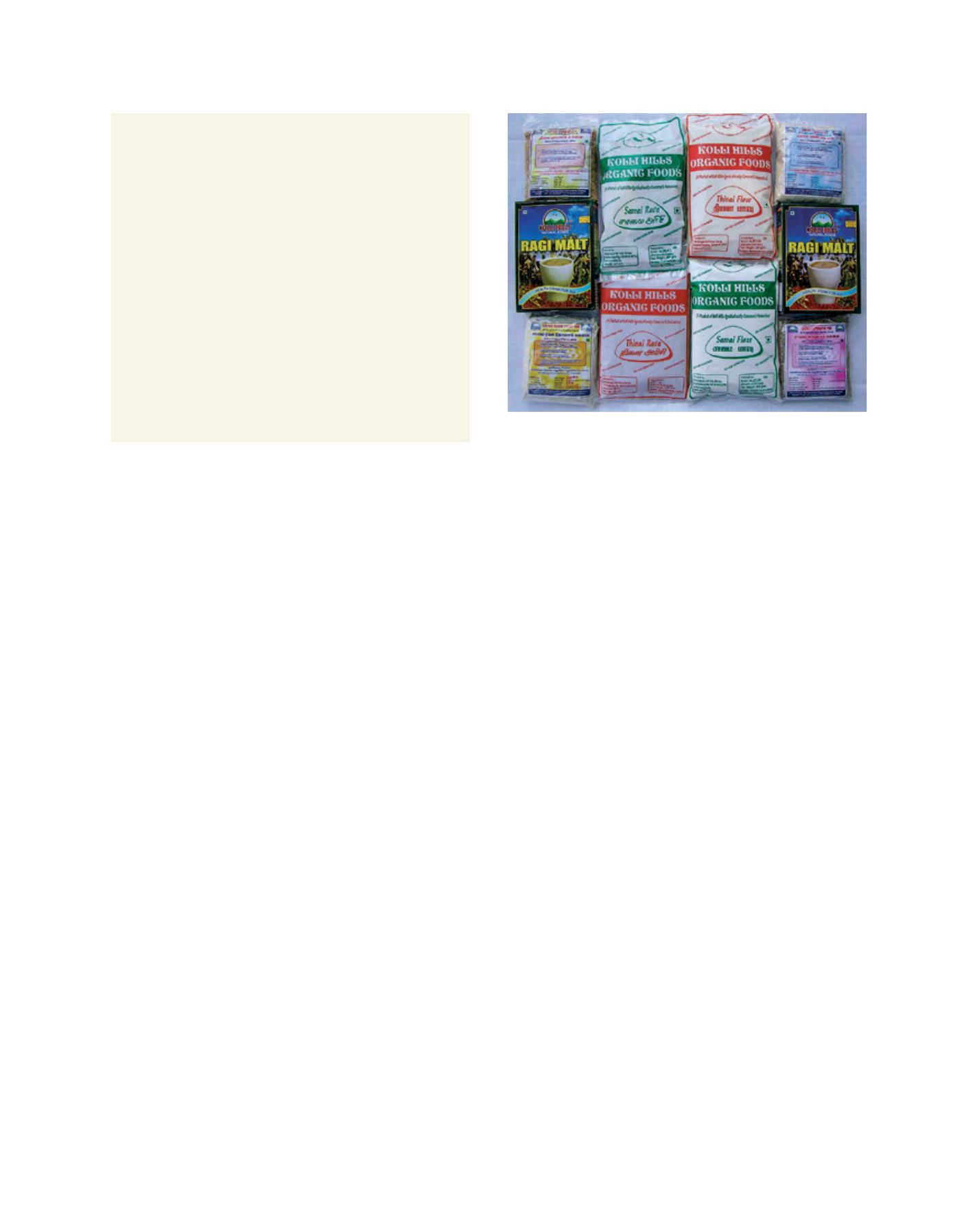

[
] 98
Some of the community institution-based agrobiodiver-
sity management practices nurtured by MSSRF in India are
described below.
Climate-smart nutri-millets in Kolli Hills
The general trend in agriculture, particularly in grain and
cash crops, is an increasing shift to monoculture, focus-
ing on a few high-yielding varieties and hybrids. Reasons
including a lesser preference for the cultivation and
consumption of millets and the drudgery of the traditional
processing involved compared to grains which are easier to
process and consume, have contributed to a reduction of
the area under millet cultivation. It is estimated that three
crops – maize, wheat and rice – contribute about 87 per
cent of all food grain production. This has led to the neglect
of a large number of diverse crops including small millets,
which have been contributing to local food security with
an important role in the livelihood of local communities in
many developing countries. Finger millet
(Eleusine cora-
cana L.)
, little millet
(Panicum sumatrense Roth ex Roemer
and Schultes)
, Italian or Foxtail millet
(Setaria italica
L.)
, Barnyard millet
(Echinochloa colona L.)
, Proso millet
(Panicum miliaceum L.)
and Kodo millet
(Paspalum scro-
biculatum L.)
are often defined as climate-smart nutritious
millets and grown over approximately 2 million hectares
across India. Millets are hardy and resilient crops in diverse
agroclimatic adverse conditions.
In Kolli Hills, located in the Eastern part of Namakkal
district in Tamil Nadu State of Southern India, the local
community had developed different cropping systems
around millets by choosing crops such as maize, pigeon pea
and mustard. These intercropping systems involve smart
risk protection combinations, while addressing diversi-
fied food and cash needs. In different regions, depending
on rainfall and distribution, they deploy millet varieties
of different maturity periods and abilities to withstand
adverse climatic conditions. However, the introduction
of commercial crops like cassava, which feeds the starch
manufacturing industry, and horticultural crops like pine-
apple, have shifted farmers from subsistence to commercial
farming, with enhanced income earning opportunity.
Further, the decline of millets is due to the immediate avail-
ability of food grains like rice and wheat supplied at highly
subsidized rates by the Government under its anti-poverty
programme, and lesser preference for the cultivation and
consumption of millets when other available grains are
easier to process and consume.
Since 1995, MSSRF in partnership with several agri-
culture research institutes and universities, state and
international agencies (the International Fund for
Agricultural Development, the International Development
Research Centre (IDRC) and Bioversity International) has
been conducting extensive participatory research work on
millets, aimed at reviving, conserving, creating economic
stakes and enhancing the scope for sustainable use of
millets. In this context, the following strategies proved
successful.
Increasing yield through improving millet cultivation practices
Together with self-help groups (SHGs), MSSRF undertook
different agronomic measures such as row planting, reduced
seed rates, application of farmyard manure, and intercropping
millet with tapioca to increase millet yield by 20 per cent and
net income by 25 per cent from its cultivation.
Introducing drudgery-free grain processing technology
All millets except finger millet have a very hard seed coat
requiring high abrasive force to remove the rice from the
seed coat. No machinery suited to these millets was avail-
able to reduce this drudgery. A collaborative project with
the University of Agricultural Sciences, Dharwad and
McGill University, Canada, supported by the Canadian
International Food Security Research Fund – IDRC, has
yielded the development of new prototype machinery for
processing little millet with processing recovery efficiency
of 90-95 per cent.
MSSRF’s role in shaping biodiversity
policies in India
In the area of biodiversity conservation, MSSRF played a key role
in giving shape to two important national legislations: the PPVFR
Act 2001 and the Biodiversity Act 2002. The draft of the PPVFR
Act 2001 emphasized the need to mutually reinforce the rights of
breeders and farmers and was presented and discussed at two
dialogues organized by MSSRF in 1994 (Farmers’ Rights and Plant
Genetic Resources: Recognition and Reward) and 1996 (Biodiversity
and Farmers’ Rights). India is the only country where farmers’ rights
have been secured by law along with breeders’ rights.
Further, MSSRF’s suggestion of recognition and reward for the
primary conservers led to the Government of India instituting two
reward systems – the Genome Saviour Award for recognition of
communities that have conserved rich genetic diversity and the
Breed Saviour Award for recognizing those who have conserved
indigenous animal breeds. It proposed the formation of biodiversity
management committees at the local/panchayat level, a biodiversity
board at the state level and a national biodiversity authority at the
central level; the National Biodiversity Act came to be in 2002.
Value-added products are being marketed in 15 districts in Tamil Nadu
province under the brand name Kolli Hills Natural Foods
Image: MSSRF
D
eep
R
oots
















